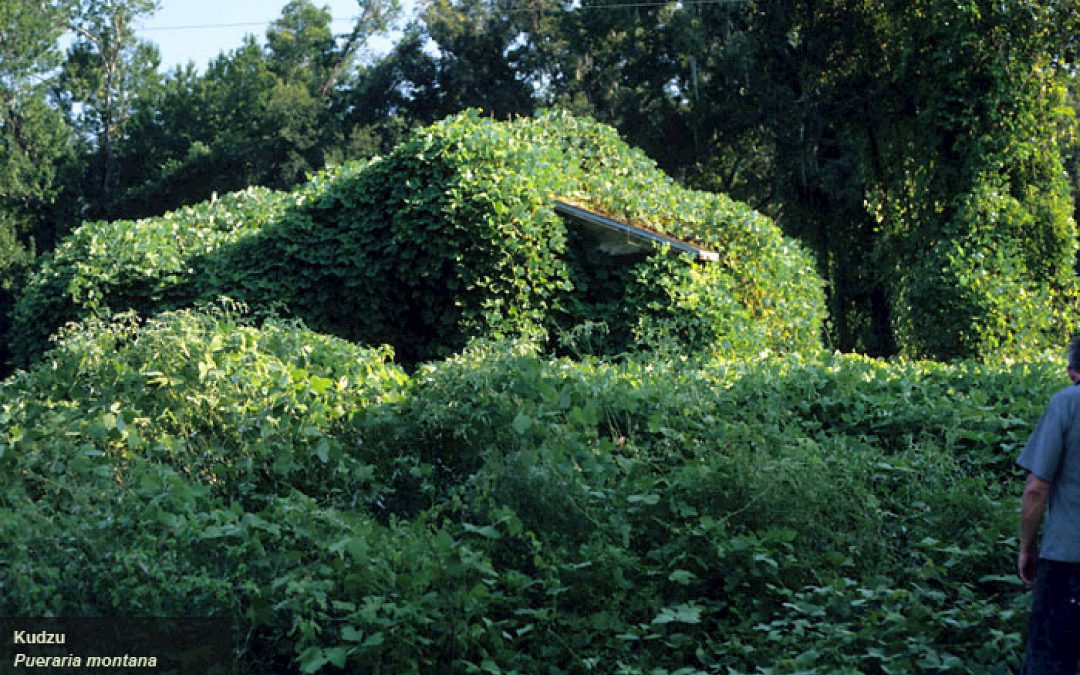
by Rick O'Connor | Jan 13, 2022
Six Rivers “Dirty Dozen” Invasive Species
Kudzu (Pueraria montana)
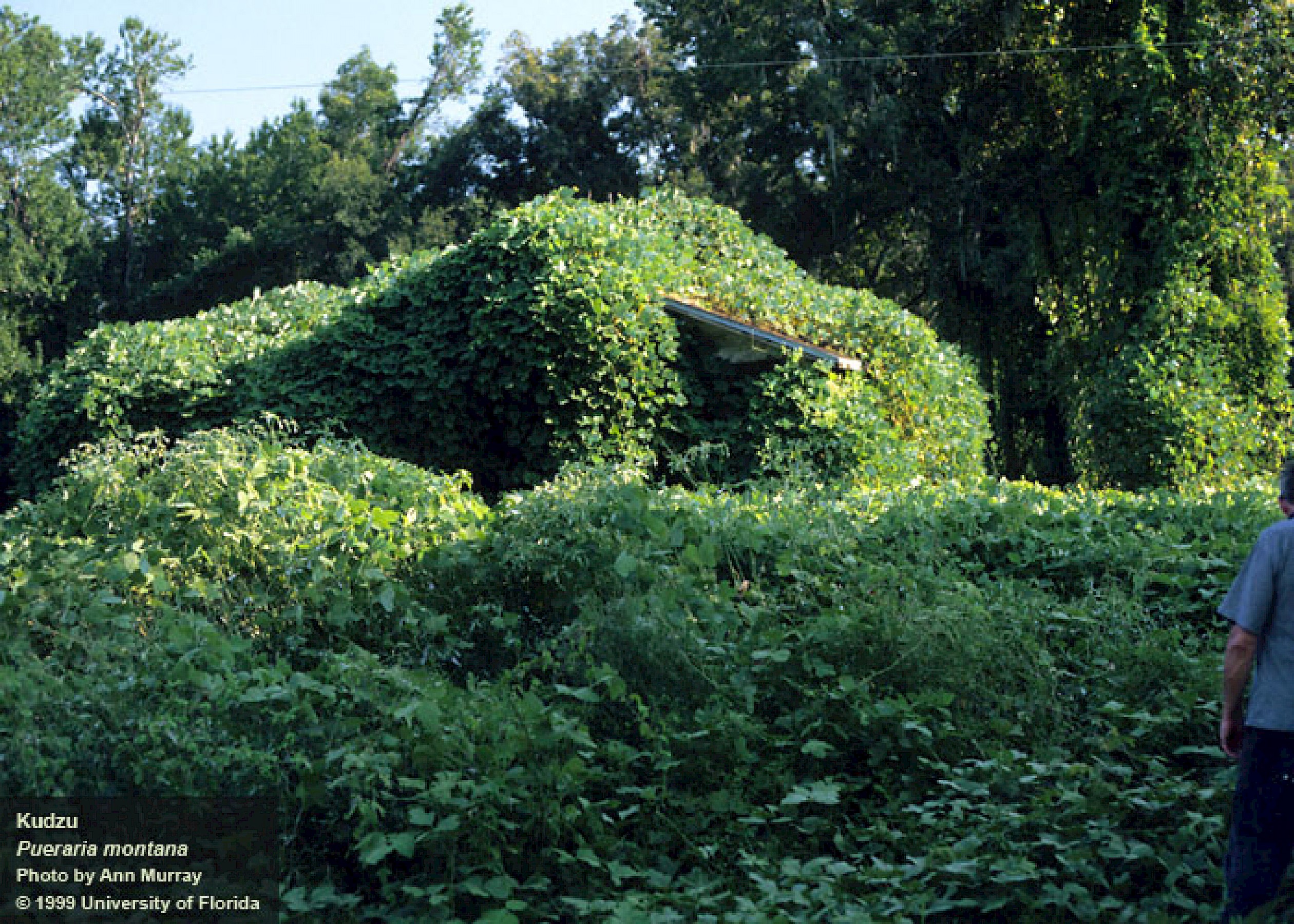
Kudzu is an aggressive growing vine found throughout the southeast.
Photo: UF IFAS Center for Aquatic and Invasive Plants.
Define Invasive Species: must have all of the following –
- Is non-native to the area, in our case northwest Florida
- Introduced by humans, whether intentional or accidental
- Causing either an environmental or economic problem, possibly both
Define “Dirty Dozen” Species:
These are species that are well established within the CISMA and are considered, by members of the CISMA, to be one of the top 12 worst problems in our area.
Native Range:
Eastern Asia.
Introduction:
Kudzu was first brought to the U.S. for the Philadelphia Centennial Exhibition in 1876. Seven years later it was presented at the New Orleans Exhibition. Seed was sold to grow ornamental vines to shade porches and was also tried as livestock feed. It now covers about 2 million acres of forest land in the southern U.S.
EDDMapS currently list 11,288 records of the plant in the U.S. As with many “dirty dozen” species, this is certainly under reported. Most are in the southeastern U.S. but there are records in Kansas, Illinois, and Oregon. It has been reported throughout the state of Florida including the Florida panhandle, and all of the Six Rivers CISMA.
Description:
This is a semi-woody vine that can grow up to 100 feet. Most who have seen it, recognize it immediately. The leaves are large (4”) and alternate on the vine forming three leaflets at each node. The leaves are lobed with hairy margins. The vines can reach 4” in diameter and one stump found in Georgia was 12” in diameter. The flowers are purple in color, hang in clusters, and appear in late summer.
Issues and Impacts:
It grows almost anywhere and over almost anything. Entire buildings have been completely covered by this plant and it has also been known to grow over and uproot trees. Any vegetation it covers will soon die due to a lack of sunlight and it is also known to harbor insects and disease for native legumes, many of which are important agricultural crops, such as soybeans. It is listed as a state noxious weed.
Management:
This is a tough plant to control. It has been reported to grow as much as a foot a day. The root and rhizomes system are extensive and reach depths of 10 feet. There are also tubers that store excess carbohydrates that help with surviving drought, freezing, and even fires.
Herbicides are effective on small patches, though repeated applications may be needed. They can be used on large areas of infestation but will certainly take repeated applications over years and can be very expensive. Many will include burning, disking, or mowing before chemical applications to weaken the root system. Chemicals that have had some success include glyphosate, chlopyraild, metsulfuron, and aminopyralid.
Many have had success using livestock grazing, such as goats or cattle. Research has shown that close grazing, where 80% of more of the plant is removed, can completely eradicate it over a couple of years. One source recommends eight goats / acre for best results. Others have had some success by cutting the plant back (like grazing) during the hottest times of the year.
No biological controls have been approved yet, but research continues.
In Asia the plant is used in a variety of ways including food, fiber, and medicine. These could be options for management as well.
For more information on this Dirty Dozen species, contact your local extension office.
References
University of Florida IFAS Center for Aquatic and Invasive Plants. Kudzu (Pueraria montana). https://plants.ifas.ufl.edu/plant-directory/pueraria-montana/.
Frank, M.S. 2021. Five Facts: Kudzu in Florida. Florida Museum of Natural History. https://www.floridamuseum.ufl.edu/science/five-facts-kudzu-in-florida/.
Early Detection and Distribution Mapping System (EDDMapS)
https://www.eddmaps.org/
Six Rivers CISMA
https://www.floridainvasives.org/sixrivers/
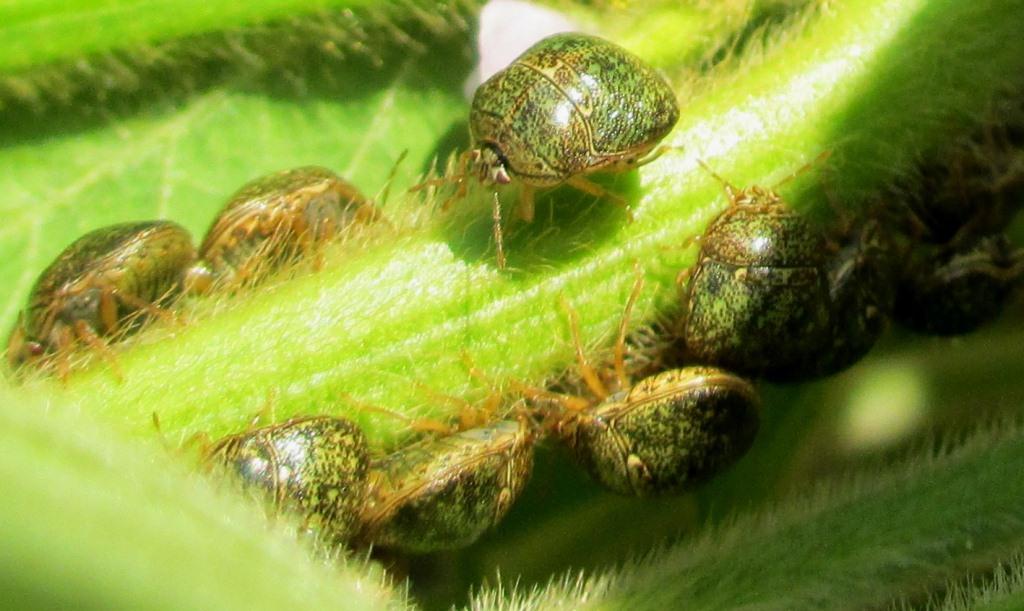
by Jennifer Bearden | Feb 24, 2015
![NISAW-logo09[1]](https://nwdistrict.ifas.ufl.edu/nat/files/2014/02/NISAW-logo091-300x119.jpg)
Kudzu Bug (Megacopta cribraria):
Florida is extending a warm welcome to a new pest! In 2012, the Kudzu bug made its first appearance in our state. And they are settling in to stay. The kudzu bug was first documented in the US in 2009 in Northeast Georgia. It has quickly spread throughout the southeast.
At first, a pest that attacks kudzu sounds pretty good but this bug also attacks wisteria, figs, and other legumes like beans and peas. It is a serious pest to soybeans that are grown in our area. They are similar to stink bugs and discharge an odor when disturbed. Skin and eye irritation can occur from this odor emission.
Kudzu bugs are small (3.5-6mm long), and are rounded oblong in shape, and olive-green in color. They lay egg masses in two rows of 13 to 137 eggs per row. The first generation of kudzu bugs seem to prefer to feed on kudzu but subsequent generations will feed on and lay eggs on other legumes. When fall comes, the adults over-winter where they can find shelter. They crawl under tree bark and into cracks in houses.

Kudzu Bugs feeding on soybean plants in Jackson County. Credit: Doug Mayo
If kudzu bugs make their way into your home, you can vacuum them up and dispose of them. If they are in your landscape or garden, you can set up a trap using a bucket of soapy water and a piece of white poster board. Kudzu bugs are attracted to lighter colors. To make the trap, cut the poster board in half. Attach the two halves by cutting a line up the middle of the two pieces and put them together. They should be in the shape of a plus sign. Place the board over the bucket of soapy water.
Insecticides can be used but timing and placement are very important. Right now, kudzu bugs are just becoming active making now a good time to spray kudzu host plants with an insecticide. Insecticide active ingredients ending in “-thrin” are effective against kudzu bugs. Controlling kudzu near your house will help decrease the number of bugs but they are strong flyers and can migrate through neighborhoods that aren’t near kudzu.
There are some natural enemies of kudzu bugs! Generalist predators like green lacewings, lady beetles, damsel bugs and big eye bugs will attack kudzu bug nymphs. There are also two parasitoids that attack them. A tiny wasp was discovered in 2013 that develops in the kudzu bug eggs. Also in 2013, a fly was discovered that lays its eggs in the adult kudzu bug.
For more information about kudzu bugs, refer to http://edis.ifas.ufl.edu/in939 or go to http://kudzubug.org
Beach Vitex (Vitex rotundifolia):
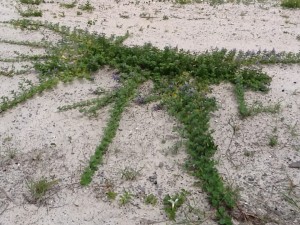
Beach vitex expands its woody rhizomes aggressively; it can actually grow over sidewalks and driveways.
Originally from the Pacific rim of Asia, Beach Vitex was brought to South Carolina to help restore dunes lost during storms. Also known as round-leaved chaste tree and pohinahina, this low-growing shrub does very well in coastal habitats. The plant is a small, deciduous shrub that can grow to a height of 3 feet and forms root and rhizome masses extending over 60 feet from the parent plant. The stems are fleshy when young but become woody with age. The leaves are simple and measure 1 – 2.5 inches in length, are ovate, and dark green on top while lower surface is light green to silver. Locally it flowers in the spring producing beautiful purple to light blue flowers. The fruit forms in mid-summer and are charcoal gray color.
Rapid growth and dense fruit production allows this plant to quickly dominate dune habitats, in some cases covering over 85% of the dune field and crowding out natives such as sea oats. The plant is also known to produce its own chemical weapons to help outcompete native species. Coverage is so thick in some areas the term “beach kudzu” is now being used. Conservation groups believe that this dense growth will negatively impact sea turtle nesting (both for egg laying adults and hatching young). In 2009 the plant was listed on North Carolina’s Noxious Weed List and there is now a statewide task force to combat this invasive. It was first reported in our area on Pensacola Beach. There are 22 known properties on Pensacola Beach and it could very well be found in other panhandle locations. Just recently, beach vitex was listed with UF/IFAS as “invasive not recommended.” If you suspect you have the plant you may contact your local Extension office for information on how to safely remove it. For more information visit www.beachvitex.org
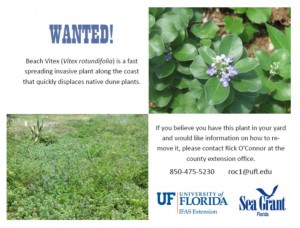
Click to download a “Wanted” Poster to share with neighbors and friends to lessen impact on our native species.
For more information, contact the author Rick O’Connor, UF/IFAS Extension Escambia County, Sea Grant/Marine Sciences Agent 850-475-5230.




![NISAW-logo09[1]](https://nwdistrict.ifas.ufl.edu/nat/files/2014/02/NISAW-logo091-300x119.jpg)


